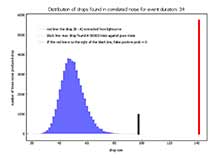


This event happens on Tuesday night at 9:38pm, prime time for teaching my Astro 8A class. Fortunately, the path crosses Aptos well, so my plan is to set up the gear behind the 700 Bldg and so I can be teaching and helping my Observational Astronomy students to work on their astrophotos from 7:30-8:45pm at which point I'll go out and set up for this event, and they can come join for the thrill of watching on the monitor as we get an asteroid occultation with our specialized gear. I've asked Karl to stay home this week, to get a track from his place, and Kirk will try from where clear skies are.
 |
 |
 |
Kirk got good data from Wilder Ranch. I recorded it from behind the 700 building at Cabrillo College with my Astro 8A students, and Karl von Ahnen got data from his home off Highland Way. A triple success! However, my recording is noisy. I believe in part because of walking by the students on the asphalt around my scope, Maybe also just my camera is not as quiet as Kirk's. My Watec 910hx camera, after testing it in the field at Kirk's station in the Astro 25 class at Carrizo Plain 2 weeks earlier, it was decided that the vertical noise banding I've noticed for some time now, is not due to my OccBox wiring or microphone wire or other antenna issues, it's the camera. Kirk's data is very solid and noise-free, and using his OccBox and my camera in his camcorder, the vertical banding was still there. So, short of getting another camera, then I'll have to live with it. So, it was with high gratitude that I found help from Tony George, who re-reduced my raw .avi file and applied a vertical noise filter inside PyMovie and got a clean enough photometry file so that PyOTE could get a solid reduction just as good as Kirk's. My timings agree well with Kirk's. Karl's camera isn't as sensitive, but it is also more noise-free, and his 16x recording was able to be reduced by me and get a 0% false positive histogram.
My own many attempts to pull a statically significant occultation event out of my messy light curve failed.... but Tony George took the .avi file and applied a vertical noise filter (badly needed for my vertical banding trouble on my Watec camera) and a fixed aperture size the same as the tracking star, and got a zero-false-positive out of the light curve. Wonderful! The time of the event is in great agreement with Kirk Bender's data, who set up at Wilder Ranch.
|
The false-positive test is passed surprisingly well. Odds of a false-positive event is zero. |
The magnitude drop was 0.77 and SNR=1.44, duration was 2.27 seconds which was about correct vs prediction and Kirk's duration. |
My students, behind the 700 building where I set up. |
A successful occultation attempt! |
If you want a good grade, be sure to smile! |
D 4:38:26.36 UTC
R 4:38:28.63
Duration 2.27 seconds
PyOTE log file from Tony's effort. and report sent 5/7/22
Kirk observed from Wilder Ranch, had dark skies and good data. He was closer to the limit for this high rank event, and so it makes sense his occultation should be a little shorter than mine. We were also offset in longitude so that may also play into the fact my longer event had a D at the exact same time as Kirk's. Or just timing uncertainty at the hundredth of a second level.
 |
 |
 |
 |
D 4:38:26.35 UTC
R 4:38:28.49
Duration 2.14 seconds
SNR 1.55
Karl was able to observe from his front yard, through trees which may have hidden some thin clouds? The light curve seems to show some slow passing clouds. I didn't notice any clouds at my site at Cabrillo College, but light cirrus isn't uncommon.
Strange that the comparison star shows such strong variations while the target star is much quieter, yet the two stars are only a couple of arc minutes apart. Some of the tracking star's variations are mirrors in the target star, so I tried using the PyOTE capability to reference the target to the tracking star as a comparison star, smoothed. However, it only made the target star noisier and ruined the non-zero false positive test, so it was not used in the PyoTE log file.
|
Screen capture of the PyMovie screen for Karl's tape. It seems each of our Team Santa Cruz set-ups has a different video pathology. Kirk's is pretty clean. Mine has bad vertical bars of noise, and Kar'ls got significant diagonal noise, which I'm not sure how to fix. |
Using a correction for the passing clouds(?) by calibrating againt the tracking star.... didn't help. It reduced the occultation to a non-zero false positive, it seems due to adding noise to the target. The target was quieter than the comparison star. Perhaps skinny bare tree branches? Karl said it was in a gap between the trees. |
D 4:38:26.26
R 4:38:28.66
Duration 2.40 sec
SNR=2.2
mag drop 0.94 which is what was predicted.